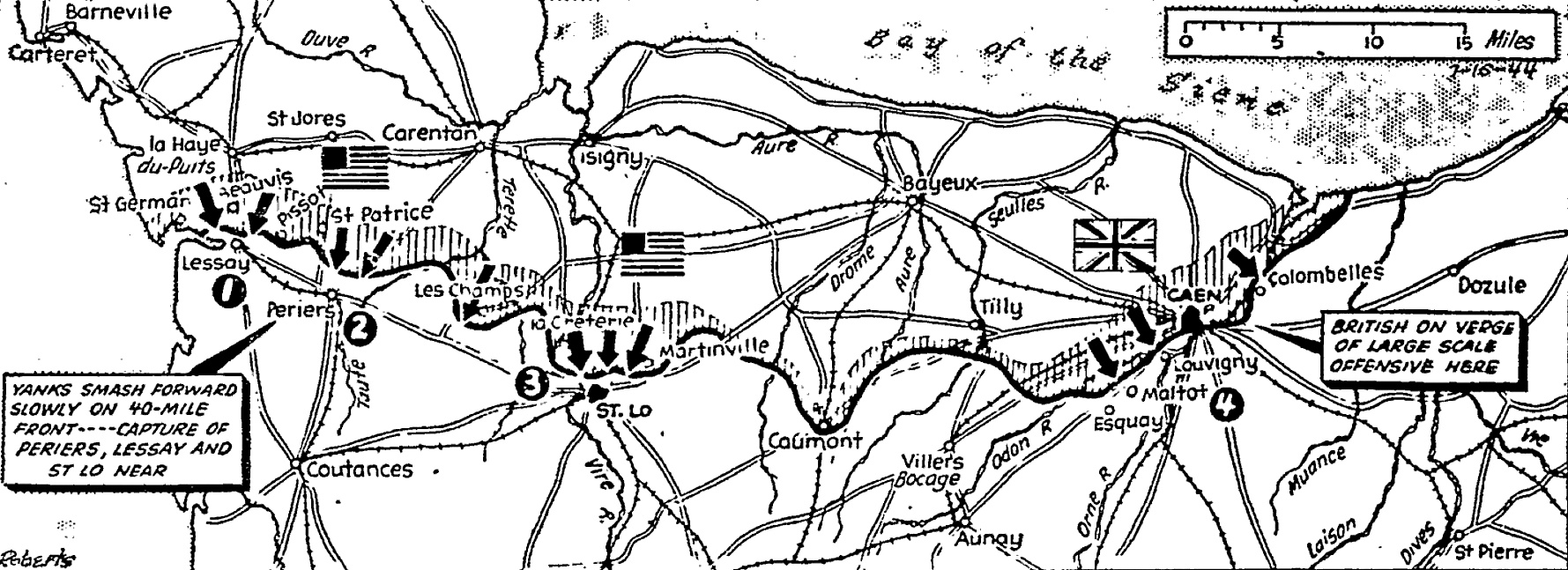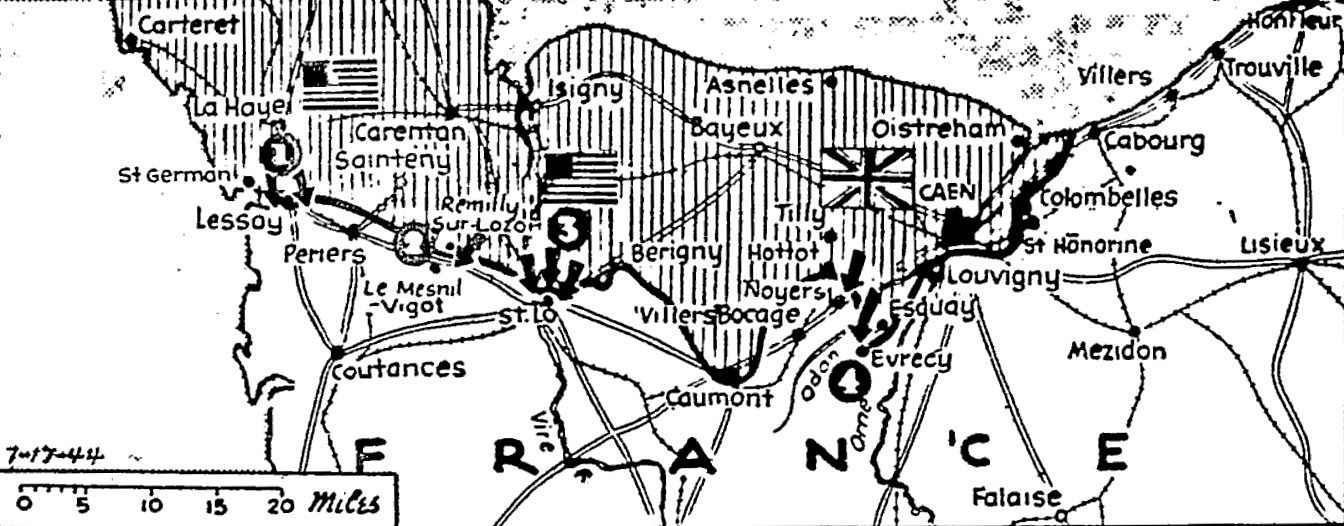The Pittsburgh Press (July 16, 1944)
YANKS CLOSE ON THREE NAZI BASES
Bradley’s men sweep through 25 more towns
Battle into Lessay and Saint-Lô, near Périers
By Phil Ault, United Press staff writer
Pushing forward slowly, U.S. forces in Normandy almost had “in the bag” the three Nazi bases of Lessay, Saint-Périers and Saint-Lô. The Americans stormed into the outskirts of Lessay (1), gained four miles north of Périers (2), and were a mile from Saint-Lô. The British front in the Caen area (4) was quiet with a big new offensive in prospect.
SHAEF, London, England – (July 15)
U.S. troops battled today into the outskirts of Lessay, west coast anchor of the German line, and swept through 25 more villages in gains up to four miles across a front stretching east to Saint-Lô, where the Yanks launched a knockout attack on that key road center.
CBS correspondent Larry LeSueur reported that the Germans evacuated Lessay as the Americans entered the outskirts under a protective shell barrage.
A great test of arms, perhaps one of the decisive armored battles of the war, was declared officially to be impending around Caen, on the British wing of the front as the Germans began a drumfire barrage in preparation for a massive counterattack.
Two miles from Périers
A German Army estimated at 100,000 men was lurching slowly backward under the steady American pounding which carried Lt. Gen. Omar N. Bradley’s troops to within two miles of a third enemy bastion, Périers, six miles southeast of Lessay.
The doughboys smashed down to the Ay River estuary on an eight-mile front from the sea to east of Lessay and pushed a spearhead within 300 yards of the heart of the small port which German rearguards were defending bitterly.
Getting across the Ay, flooded by the Germans to a width of several miles, presented a serious problem but the companion advance in the Périers direction was threatening to outflank the water barrier.
Ground regained at Saint-Lô
For the fifth straight day, the Yanks launched a dawn attack on Saint-Lô, this time starting suddenly without a preparatory barrage and in the first hour driving back to the area of Martinville, a mile east of the wrecked city, after having given ground in that area Friday under counterattacks.
Saint-Lô was virtually encircled with the Americans holding dominant ground on all but its south and southwest approaches. The new attack was called officially a “strong action” designed to bring about Saint-Lô’s fall.
The heaviest enemy shelling since the Saint-Lô attacks began met the U.S. infantrymen and a few German tanks rumbled into action, precipitating heavy battles which were reported still raging late Saturday.
Massive infantry surge
United Press’ James C. McGlincy reported that Saturday’s advances on Saint-Lô consisted of the reduction of three powerfully fortified hedgerows in close-quarters fighting recalling the massive infantry surges of the last war.
German SS Elite Guard officers were threatening to shoot the city’s defenders if they wavered, another United Press front reporter, Henry T. Gorrell, said, “and even the cocky paratroopers, the cream of the German Army, now are digging furiously to stem the machine-like advance of the U.S. Army.”
These desperate measures were costing the Yanks heavily for every yard gained, but slowly and surely the front reports said, the Germans were giving way and suffering enormous losses which were almost impossible for them to replace.
Yanks bury 6,349 Nazis
It was announced that since D-Day, the Yanks have buried 6,349 German soldiers whose bodies had been left behind by their retreating comrades.
The Americans advanced a mile on a four-mile front in the Lessay sector, maintaining their mile-a-day pace since launching their attack down the west side of the Cherbourg (Cotentin) Peninsula 12 days ago.
The most sweeping gains of the day, up to four miles, came in the center sector above Périers where the Americans plunged ahead at an accelerated pace after joining up
They captured Saint-Patrice-de-Claids, three miles north of Périers and six towns on the northeast approaches of the town, and Crèvecœur and Deauville on the road from Saint-Jores.
The Americans drove within a mile of the important Lessay–Saint-Lô lateral road, putting it within easy field piece range and limiting the Germans’ use of it, captured in this sector were La Grande Hairie and La Creterie.
The Americans were driving on without air support through a heavy ground fog and an intermittent drizzle in advances which placed Saint-Lô, Lessay and Périers within their immediate grasp.
Shortly before noon Friday, Gen. Bradley had ordered his troops to step up the attack on the three resistance centers. Slowly, like a creeping tide, the front was squaring out as the Yankees gained elbow room which will pay heavy dividends when armor is thrown into the battle on a grand scale.
Every sign pointed to the early beginning of the biggest battle of the invasion in the Caen sector, where about 200,000 German troops with the better part of six panzer divisions were aligned against Lt. Gen. Sir Miles C. Dempsey’s British 2nd Army.
Nazi attack expected
The entire British sector was ominously quiet except for patrolling and the swelling German barrage which a commentator said meant that “there is pending a very large-scale German attack.”
The attack was anticipated with some satisfaction for the best formula for sweeping advances is to smash the enemy’s armor in one major battle, as Gen. Sir B. L. Montgomery demonstrated in his desert campaigns.
A front dispatch from Ronald Clark, United Press writer with the British said a flood of Allied men and material was pouring into the Anglo-Canadian line.
The air forces were able to put in only 1,000 sorties Friday, one-eleventh of D-Day’s display, but fighters scored heavily in dogfights with German formations, shooting down 25 enemy planes.
Only about 50 sorties were flown during Saturday’s muggy forenoon.

